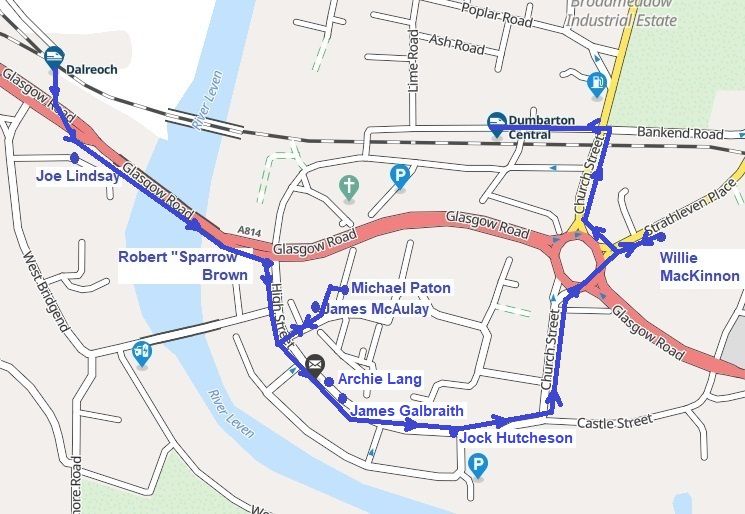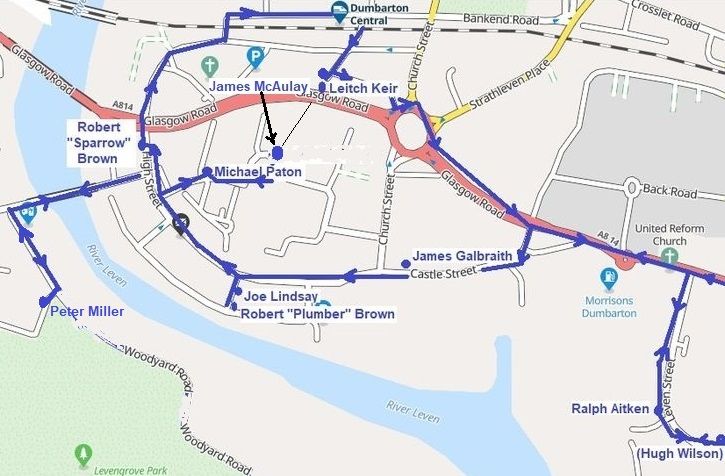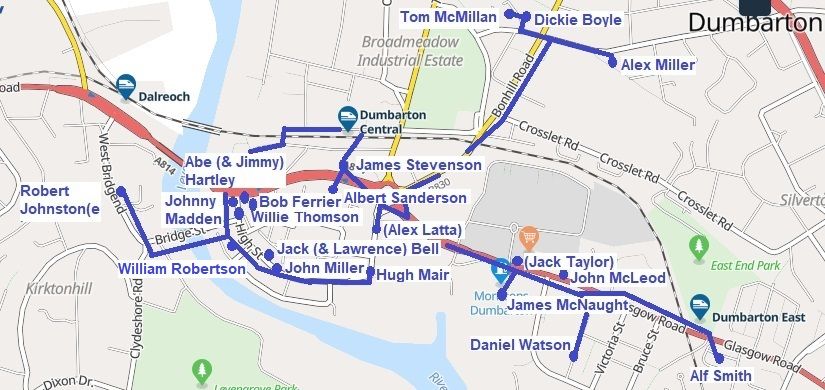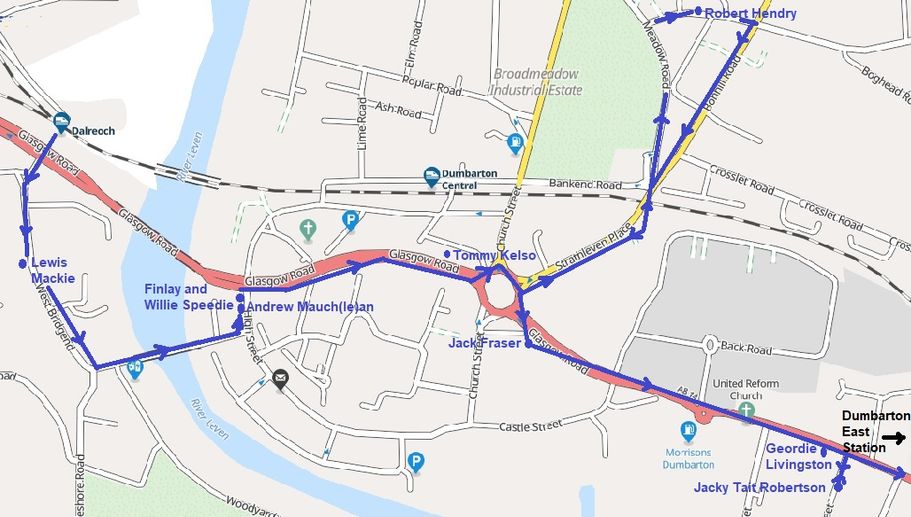The Dumbarton Strolls
Whilst Vale of Leven F.C. must be considered the first working-class team anywhere in the World to achieve footballing success and neighbouring Renton a decade later the one in creating the organised mid-field and therefore to have revolutionised the British and thus the World game, it is the third Leven Vale team, Dumbarton, that very much carried the flag in the intervening years. Over a decade and a half from 1880 it produced three teams that rivalled and sometimes beat all-comers in the Scottish Cup, with the middle one of them also finishing in joint first-place in the inaugural Scottish League of 1891, narrowly missing the Double, and winning the 1891-2 League outright. And like Vale of Leven with Bonhill and Renton it did so largely with local talent, traces, or at least echoes, of whose lives can still be found today in our four strolls.

Strolls One and Two
Strolls 1 and 2 are designed to be done either separately or together. They basically include the players that made the first team of note, 1, those who were local born and bred, 2, those from One who moved within the town or whose parents were drawn in by then booming industries.
Stroll 1 is designed to start at Dalreoch, the next station beyond Dumbarton Central in the direction of Helensburgh. Exit it, cross the Glasgow Rd. and stop and lean on the metal railings. In front of you are the lawns and high-rises that have replaced the once-teeming William St.. It was the childhood home at No. 17 of Joe Lindsay, from 1877 to 1893 goalkeeper for his home-town team, for Renton and nine times for Scotland.

Continuing on, cross the River Leven by the Glasgow Road bridge to the lower end of the High St., on the corner of which was the home of Sparrow Brown, in 1884 the winner of two caps. He stayed in the tenements that once stood there, at No. 209. Then up the High St. after hundred yards you have on the left Risk St., where James McAulay, nine caps in five years, and Michael Paton, five caps in six years, both grew up.
Returning to the High St. turn left once more and, as the numbers descend, you will pass James Galbraith at No. 101, Archie Lang, with a single cap, at No. 97, later No. 199 and Jock Hutcheson at No. 46. Then at the top, turn left into Church St. taking it and crossing to Strathleven Place via the far-end roundabout. No. 16 was the home of Willie McKinnon with thirteen years service to his home-town club and four caps.
From Strathleven it is a short walk to Dumbarton Central station and the journey home and it is also from Dumbarton Central that Stroll 2 starts and where it also finishes. It is a tour that can be done in either direction but here we will do it clockwise. So coming out onto Bankend Rd. turn left and left again through the tunnel under the tracks. You will find yourself at the head of College St. at the top end of which at now crumbling No. 93 lived perhaps the greatest of the Dumbarton players of the era, Leitch Keir. And by that time James McAulay had also move to College St. but No. 2 so at the other end, best accessed from where he had previously stayed on Risk St.
Then from College St. take the side road that runs past the Dumbarton Municipal Building parallel with Glasgow Rd. eastbound to the roundabout beyond, crossing it onto Glasgow Road eastward. Admittedly Glasgow Rd. is not the most scenic of walks but have faith. Two hundred yards further on and there is smaller roundabout with a Morrisons on the right. Cross towards the supermarket but continue on the main road for a hundred yards more before turning right. By doing so you enter Leven St., or at least was is left of it. Ralph Aitken stayed at Nos. 17 and 41 before winning one cap, going South to Newcastle West End, one half of the future Newcastle Unuted, and returning to win a second international honour. And finally for this part of the tour there is Hugh Wilson, again a winner of a single cap. He would come to the town from Mauchline and live in the first turning left off Leven, at No. 10 Wallace St.. The house is no longer there but most of the street is, the first real example en-route of an old Dumbarton swept largely away by new-build.
Take the walk up Wallace St. and at the top turn again onto Glasgow Rd., retracing your steps, this time back past Morrisons until the wee cut-through by the Scottish Maritime Museum and Castle Terrace to or Castle St. itself is reached. Whichever way then take the latter all the way to the junction with Church St.. On the way pause at Nos. 25 and 27. They were again the homes of an older James Galbraith. Then carry on onto quiet, older, top end of the High St and, as the buildings turn to shops, second on the left, now a paved cut-through, is Quay St. It was where Joe Lindsay had moved from William St. and where, at Nos 1 and 6 respectively, he joined Plumber Brown, winner of a Scottish cap in 1885.
Now at this point you have a choice. First there is the length of the High St. past Risk St. and Sparrow Brown at 209 before a return to the station via the loop that is Station Rd.. The second is a pleasant excursion to what was the home of Peter Miller. He would from 1875 serve Dumbarton for twelve seasons, in two parts, nine and three with a season at Partick in between. He would in 1882-3 also make three international appearances, He might even have gone on to play at least semi-pro in England, in Hartlepool but he lived either at 17, Levenford Place, which became today's Levenford Court and 17, West Bridgend or at 17, Levenford Terrace. For the former Take Bridge St., the old bridge across the Leven, to where it turns right into West Bridgend and the location is in front of you or for the latter immediately turn left into Woodyard Rd. following it for a hundred yards. Levenford is third on the right overlooking Levengrove Park and the river.

Stroll Three (Above)
This third Stroll, by far and away the longest and perhaps worthy of a car or bike, is again one that can be taken in either direction and it can begin and end at Dumbarton Central or start at the former and end at Dumbarton East. This description takes the latter option and goes anti-clockwise. It is also the one that covers the second and greatest of the Dumbarton teams of the period, the lasting influence of which was ultimately felt not just in Scotland and England but as far as today's Czechia.
From Central turn left into Burnbank Rd. and follow it until the bottom of the High St. is reached at the Glasgow Rd. Between it and Bridge St. the tenements, the closes that had already been the source of Sparrow Brown now also produced the brothers, Abe and Jimmy Hartley, Bob Ferrier Snr, Willie Thomson and Johnny Madden. Thomson and Madden would win six caps between them but here was the difference. Brown had played only locally, whereas the new wave went South; the Hartleys to Everton and beyond and Lincoln and others respectively, Ferrier to Sheffield Wednesday, Willie Thomson, albeit briefly, to Newton Heath, Manchester United in embryo, and Madden to Celtic via Gainsborough and Grimsby. And, of course, Madden would be with Eaglesham's John Dick one half of the Scots duo that took the beautiful game to the Pragues, Slavia and Sparta.
Then comes a slight diversion, a there-and-back. Robert Johnston, or Johnstone as he became in England, lived half-way up West Bridgend at No. 58. After three seasons at his home-town club he would play for Renton, Sunderland, Third Lanark and Dunfermline. And West Bridgend can be found by turning left from High St. at Bridge St. and crossing the bridge itself. But back on High St. and moving further up you will find the childhood homes at Nos. 147 and 157 of Willie Robertson, the amateur exception that proved the rule, then more footballing brothers, the Bells, Jack and Lawrence, at No. 121 and that of John Miller at No. 101. Jack Bell would win ten Scottish caps, either side of Scottish professionalism, hinting that it might otherwise have been more. He would also play for Everton in two stints, Preston North End with Celtic in between. Lawrence Bell's thirteen year career would take in Third Lanark, Sheffield Wednesday, Everton, Bolton etc., and John Miller's Wednesday, between Liverpool and Derby County.
Now at the top of the High St. turn left into Church St.. This is where Hugh Mair lived at No. 7 and Alex Latta at No.45. Mair was a Dumbarton forward for a decade. Latta would win a single Scotland cap before, over six seasons, making one hundred and forty-eight appearances for Everton followed by a further year with Liverpool.
At the top of Church St. we are back at roundabout on the Glasgow Road. As before cross it into Strathleven Place and continue up and onto Bonhill Road and where Poindfauld Terrace joins from the left and Round Riding from the right. Left is where Tom McMillan and Dickie Boyle lived, both on first right Allan Place, the former at No. 7, the latter at No.1, having moved from 9, College St. so by Leitch Keir. McMillan would stay at home and win a single Scottish cap, Boyle would play alongside Latta at Goodison, making a total of two hundred and forty-one starts between 1892 and 1901. Right are the various childhood homes, all around Boghead, of Alex Miller, Boghead Park being the Dumbarton ground at the time. He would also stay local but in his case for a full decade.
Retracing your steps back to the Glasgow Rd. roundabout now turn left eastbound and to Morrisons once more. It stands now on what was once Clyde St. James McNaught lived on it at No. 44 and Jack Taylor at No. 19 before moving to nearby Jamesfield. Indeed Dickie Boyle spent his early years at No.1. McNaught would go South to Newton Heath once more and Spurs, Taylor to St. Mirren, four hundred games for, like several full or near contemporaries, Everton and four Scotland caps. And beyond Jamesfield still on the Glasgow Rd. lived goalkeeper, John McLeod. A Dumbarton man through-and-through apart for five games for Rangers at the very end of his career he was born on the High St., brought up at Greenfield, then a market garden now houses backing onto the St James Retail Park and then lived at No. 73 and would also have five Scottish appearances to his name.
So now there remain just four more players in a stroll that has taken in sixteen already. Two are in the sides streets close to Dumbarton East station. They are Daniel Watson and Alf Smith. Both played out their careers in Scotland, the former solely at Dumbarton, the latter splitting his time at his town-club and Third Lanark. Neither was capped. Watson stayed on Wallace St. by Hugh Wilson and then Plumber Brown. Smith was at 5, Burnside Terrace, just to the east of the railway. The two others are on the return to Dumbarton Central. The first is James Stevenson, who grew up first on Church St. with Latta and Mair and then finally on College St. at No. 75 again by Leitch Keir. And Stevenson, whilst he would never be capped as his neighbour had been, would start and finish at Dumbarton with an eight year down South between, mainly at Preston and West Bromwich. The second is Albert Sa(u)nderson, a duck through the underpass to where No. 45 once stood and is now the Risk St. car-park. He would spend five seasons solely at The Sons before moving to Newcastle, an economic rather than football migrant.

Stroll Four
And so to the fourth and last of the Dumbarton Strolls to be taken individually or, at a push, together. It takes in the last flourish of a Dumbarton team that in March 1897 reached the Scottish Cup Final in 1897 before, just five season after being League champions, dropping out, albeit temporarily, of the Scottish League system altogether. It is also a stroll that is long in distance, few in player number and can either begin and end at Dumbarton Central, start at Dalreoch and finish at Dumbarton East or even at any combination of the above. However, for the sake of this itinerary we will describe the first of the options.
So exit Dalreoch Station and cross the Glasgow Rd. into West Bridgend. Lewis Mackie, a member, seemingly aged just seventeen, of the 1897 Cup-losing eleven, lived at No. 105. Then at the end of road turn left into Bridge St., cross the river and on High St. left once more, where the tenements that had already given Dumbarton F.C. and the wider footballing World Sparrow Brown, the Hartleys, Willie Thomson, Bob Ferrier and Johnny Madden now produces Andrew Mauchlen or Mauchan and Finlay Speedie and bother, Willie. In fact the Speedies seem to have lived at the same addresses, No. 209 and No. 210 respectively, as both Brown and Madden, although ten years apart in each case. And those addresses was from where Finlay would go on to Rangers for six seasons, two more at Newcastle and win three caps before a return home, Willie and Mauchan also be part of the Cup eleven, with Mauchan staying at home and Willie moving on to Third Lanark.
Then it is along Glasgow Road eastwards to what was College Park St.. Now cleared and the site of the Dumbarton Municipal Building Tommy Kelso stayed at No. 7. Renton-born and the nephew of the former Renton player and Scotland international, Bob Kelso, he would be awarded one cap but only after beginning at Third Lanark, a long stay South with Manchester City and a return to Dundee. Then it was Rangers and home-town once more.
Now continuing on, at the roundabout that the Municipal Building overlooks turn left into Strathleven Place, over the railway and left again into Meadow Rd., following the park to Poindfauld Terrace, the teenage home of Robert Hendry, another of the Cup team. That is before a return via a right into Bonhill Rd. and Strathleven once more to the Glasgow Rd., where it is left once more and across. There Jack Fraser lived at 1, MacLean Place, no longer there but then by the prison and now by the Sherriff Court. He would win a single cap, play at Notts County, Newcastle and Southampton but also for Motherwell and St. Mirren, ending with one hundred and eighty-eights starts also for Dundee.
And finally, continuing along Glasgow Road to East station, beyond Morrisons once more, we pass an earlier home of Tommy Kelso at No. 8, Glasgow Rd. and at No. 64 that of Geordie Livingston. He would win two caps during a fifteen year career that would include times at Hearts, Sunderland, Celtic, the Manchesters, City and United, and Rangers, and even a year managing Dumbarton itself. And last but not least there would be Jacky Tait Robertson. He would be just round the corner, a third to stay on Wallace St., this time at No. II, from where over seven seasons he would make sixteen international appearances, whilst turning out for Morton, Everton, Southampton, Rangers and Glossop with in-between a year at Chelsea, where he was its first League captain.